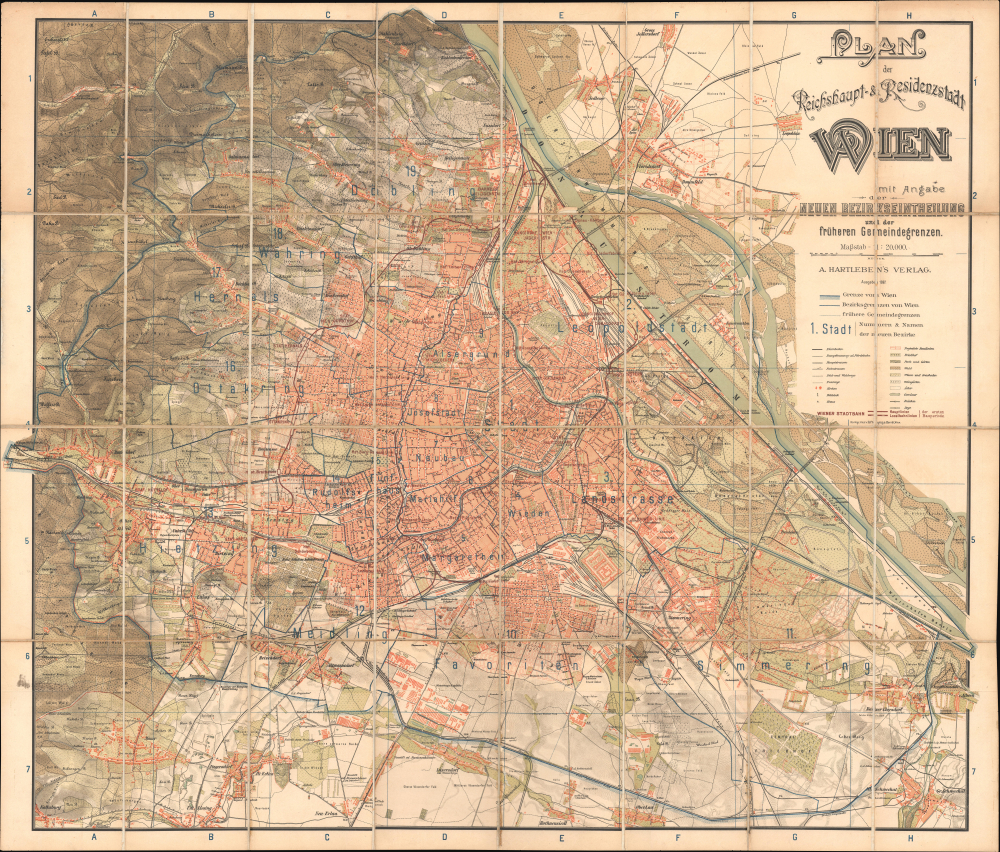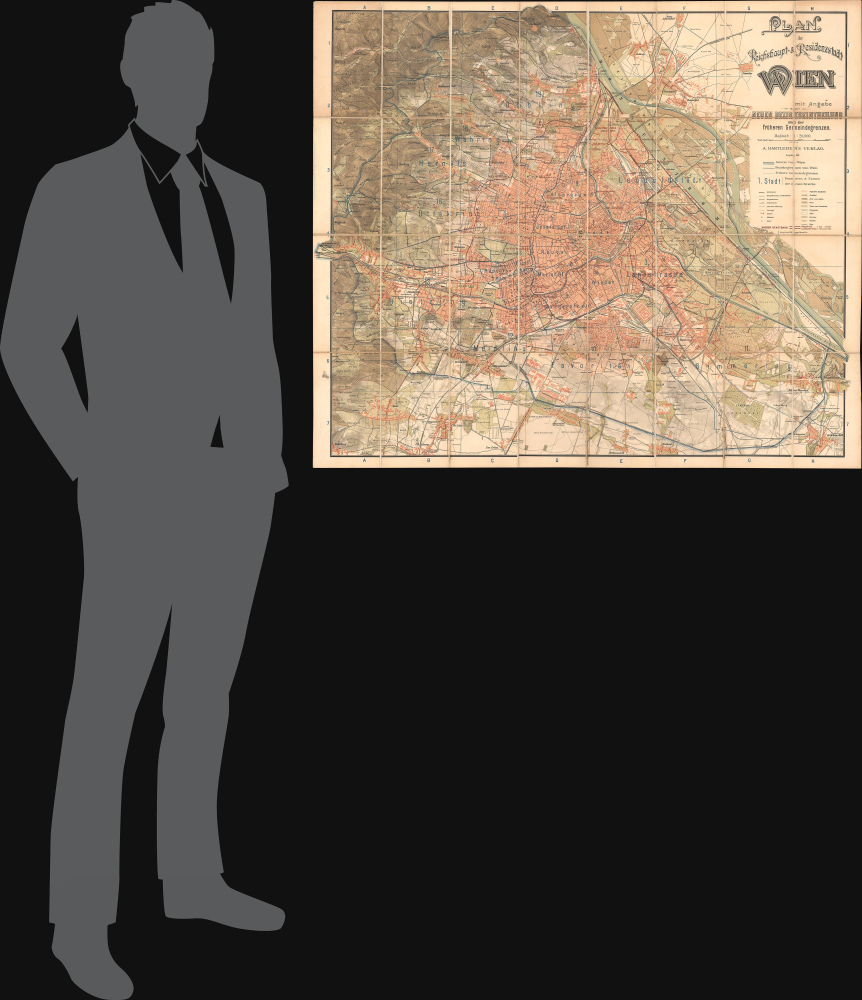1897 Hartleben / Freytag Folding Map of Vienna, Austria
Wien-hartleben-1897
Title
1897 (dated) 39 x 33.25 in (99.06 x 84.455 cm) 1 : 20000
Description
A Closer Look
Vienna is displayed as divided into Bezirke (districts), noted with bold blue lines and labeled with blue text. The city's boundaries had expanded and its districts were reorganized in the early 1890s (the 'Neuen Bezirkseintheilung' referred to in the subtitle), with suburbs beyond the city's former outer wall (Linienwall) becoming districts 11-19, explaining their odd boundaries here which resemble the jagged lines of fortifications. The reorganization was necessary as the city's population grew consistently across the 19th century, roughly 20-30% each decade after the conclusion of the Napoleonic Wars (1803 - 1815). Drawing a wide range of peoples from throughout the Austro-Hungarian Empire, Vienna was at this time the third or fourth largest city in Europe, behind only Paris, London, and Berlin.The map provides extensive detail on several classes of streets and roads, as well as railways, canals, churches and religious sites, graveyards, parks, gardens, markets, palaces, military facilities, and more, as well as fields, farms, and vineyards on the outskirts of the city. Areas of planned construction are ghosted in with dashed lines, as in the city's 11th District, Simmering, at bottom-right (its Central Friedhof cemetery is still one of the largest in Europe).
Fin-de-siècle Vienna
Vienna at this time was one of the most vibrant cities in Europe, with opulent Neoclassical structures, wide tree-lined boulevards, booming industry, excellent public transportation (including the Wiener Stadtbahn, influenced by the London Underground, noted as in the 'first construction period' at this time), a thriving arts scene, and a colorful, cosmopolitan mix of ethnicities and cultures from throughout the Austo-Hungarian Empire. The city had been largely remade in the second half of the 19th century, with the Danube River channeled and regulated by dams, canals, and levees, and the old (inner) city walls being replaced by wide boulevards collectively known as the Ringstrasse, which was lined with majestic buildings for government ministries, cultural institutions, and palaces for the nobility, built in a Neoclassical style that came to be known as Ringstrassenstil. The reduction of the old city walls and their replacement with the Ringstrasse and its associated structures was not completed until 1913, by which time Ringstrassenstil had become passé and was replaced by more innovative designs driven by members of the Art Nouveau (Jugendstil)-affiliated Vienna Secession movement such as Otto Wagner (1841 - 1918, who had also designed the beautiful Karlsplatz Stadtbahn Station).The zeitgeist of fin-de-siècle Vienna was retroactively summarized by Stefan Zweig in his memoir The World of Yesterday (Die Welt von Gestern) thus:
the genius of Vienna, a specifically musical genius, had always been that it harmonized all national and linguistic opposites in itself, its culture was a synthesis of all Western cultures. Anyone who lived and worked there felt free of narrow-minded prejudice. Nowhere was it easier to be a European…Such a dynamic, bubbling mix of cultures, technologies, and ideas germinated a broad range of innovators, including - in addition to Wagner and Zweig - Sigmund Freud, Gustav Mahler, and Gustav Klimt, among others. In their wake, even more avant-garde forms of thought and expression would take root in the city, including the works of philosopher Ludwig Wittgenstein, artist Oskar Kokoschka, and composer Arnold Schoenberg.
All was not well in Vienna, however, and the decadence of the era was counterbalanced by social upheaval and political unrest. Industrialization had created an urban working class that was as restive as any in Europe and socialist movements proliferated. Sometimes the backlash against modernism took the form of Antisemitism, as Jews constituted roughly 10 percent of the city's population (many of them living in Leopoldstadt), though they were internally differentiated by class, profession, and religious observance (including assimilated Jews who may have converted to Christianity, at least nominally).
The combined forces of modernism and the reactions it provoked (or, as Freud might have it, civilization and its discontents) were exemplified by the Christian Social Party and its leading figure, Karl Lueger, who served as mayor between 1897 and 1910. Combining Catholicism, Populism, Antisemitism, and Modernism, mixed in with adept political acumen, Lueger and his allies dominated city politics at the turn of the century and, after the implementation of universal male suffrage in 1907, would duke it out with the left-wing Social Democrats for years. Despite his frequent invocation of Antisemitism, Lueger is also remembered for his major public works projects that developed modern infrastructure (sanitation, transportation, electrical, etc.) and beautified Vienna. He and his Christian Social movement are often seen as a model for the Nazis (young Adolf Hitler lived in Vienna between 1907 and 1913), though Lueger rejected the pan-Germanism that ultimately led to the Anschluss.
The rise of the Christian Social Party in the early 1890s also exerted a strong influence on Theodor Herzl, working as a journalist in Vienna at the time, and helped prompt his turn towards Zionism. In fact, it may have had a greater impact on Herzl than the Dreyfus Affair in France, on which he reported while writing for the Viennese paper Nieu Freie Press and which is generally credited for his conviction that Jews must found their own nation-state. In any case, the same year of Lueger's election and the publication of this map, Herzl founded the Zionist newspaper Die Welt in Vienna, which became the main mouthpiece for Zionism. The following year, his play 'Das Neue Ghetto' was staged for the first time. The play was written in 1894, before Herzl was a convinced Zionist, though the experience of writing the work seems to have played an important role in convincing him. Set in Vienna, the play's plot emphasizes the precarious existence of assimilated middle-class Jews in the city, ending with the haunting line 'they won't let you live unless you learn to die.'
Chromolithography
Chromolithography, sometimes called oleography, is a color lithographic technique developed in the mid-19th century. The process involved using multiple lithographic stones, one for each color, to yield a rich composite effect. Oftentimes, the process would start with a black basecoat upon which subsequent colors were layered. Some chromolithographs used 30 or more separate lithographic stones to achieve the desired product. Chromolithograph color could also be effectively blended for even more dramatic results. The process became extremely popular in the late 19th and early 20th centuries when it emerged as the dominant method of color printing. The vivid color chromolithography produced made it exceptionally effective for advertising and propaganda imagery.Publication History and Census
This map was prepared by Freytag and Berndt and published by A. Hartleben's Verlag in 1897. It is one of a series of similar large-format folding maps produced by Freytag and Berndt in the late 19th and early 20th century, sometimes with slightly different titles. However, these maps tend to vary considerably, not only due to the rapid evolution of the city. The present map differs notably from the almost-identically-titled 1895 edition in size, scale, and content, highlighting the new city districts. It is also the first edition published in conjunction with Hartleben.Regardless of edition, the map is scarce, and we do not find any market history of this edition, with only one institutional holding at the Wien Museum. The David Rumsey Historical Map Collection holds the 1895 edition and Princeton University holds an edition from 1900.
CartographerS
Freytag and Berndt (1770 - Present) is a map, atlas, guidebook, and travel literature publisher. Its roots reach back to when Francesco Artaria founded a lithographic works in Vienna in 1770. In February 1879, Gustav Freytag founded a cartographic publishing house. Freytag and Berndt merged with the cartographic division of Artaria in 1920. After World War II, Freytag-Berndt und Artaria experienced expanded publication to become one of the most important cartographic publishers in Central Europe. Today, Freytag and Berndt publishes street maps, city map, hiking maps, and cycling maps and employs fifty cartographers and editors at their headquarters in Vienna. More by this mapmaker...
Conrad Adolf Hartleben (August 26, 1778 - April 5, 1863) was a German bookshop owner and publisher who founded a company bearing his name that became one of the largest publishers in the Austro-Hungarian Empire at the turn of the 20th century. Hartleben was born in Mainz but in 1802, at the age of 24, relocated to Buda (now Budapest) where he took over a bookstore owned by Sigmund von Ivanics. Two years later, he established his own bookshop and publishing house in Pest. Hartleben displayed a skill with business and was able to expand the bookstore to Vienna and Leipzig, moving the company's headquarters to Vienna in 1844. In 1859, Hartleben co-founded the Austrian Booksellers' Association (Verein der österreichischen Buchhändler). By the time of his death, Hartleben had turned his company into one of the most prominent publishers in the German-speaking world, especially in the Austrian Empire (soon rechristened the Austro-Hungarian Empire). After Conrad Hartleben's death, his great nephew Adolf Hartleben (1835 - 1903) took over the company. The Pest and Vienna branches of the company split, the former focusing on bookselling and the latter on publishing. By 1869, Adolf Hartleben handed management of the company over to a trusted employee, the capable Eugen Marx (1844 - 1934). The bookselling business in Pest was sold off in pieces to rivals or employees and the parent company turned its focus to publishing. Marx imported state-of-the-art printing presses, the most advanced available in Vienna at the time, allowing the company to become a fixture of the publishing scene of the late 19th century German-speaking world, publishing the earliest German translation of Jules Verne's 20,000 Leagues under the Sea (20.000 Meilen unter dem Meer). The company was badly hurt by the First World War, during which Marx passed management to his son Richard Marx, who oversaw it until 1947, by which time the Second World War had caused even more damage. In the postwar period, the company was reborn under the leadership of Walter Rob (with the company renamed A. Hartleben, Inhaber Dr. Rob) but never regained its earlier prominence. In 2007, the company was sold but its name remains in its successor, HERA A. Hartleben GmbH, based in Vienna. Learn More...




